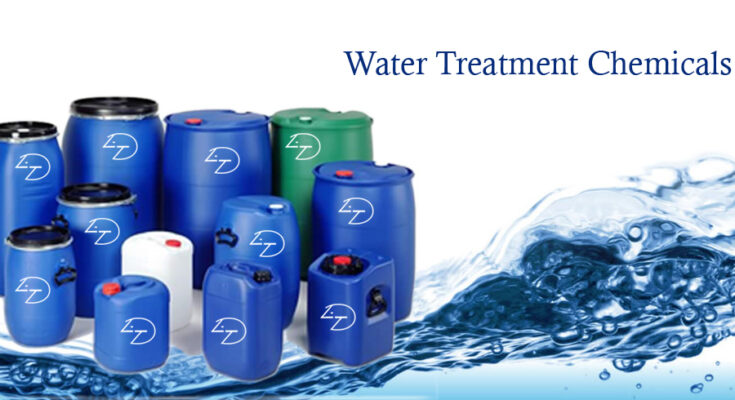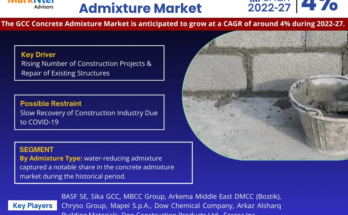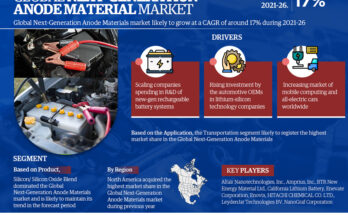France Water Treatment Chemicals Market has valued at USD1.72 billion in 2022 and is anticipated to project robust growth in the forecast period with a CAGR of 4.48% through 2028. Stringent regulations and policies by the French government related to water and wastewater treatment have increased the demand for treatment for France’s water treatment chemicals market. For instance, according to the UWWTD, France must apply biological treatment with nitrogen and phosphorus to remove at least 75% of nitrogen and phosphorus from the wastewater generated in some parts of the territory. Moreover, as one of Europe’s most populous countries, France continues to experience population growth and urbanization. With an increasing number of people residing in cities and urban centers, the demand for clean and safe drinking water rises significantly.
As a result, water treatment facilities are under pressure to ensure a consistent supply of high-quality potable water, which drives the demand for water treatment chemicals that can effectively treat and purify water on a large scale. According to the world data, from 1960 to 2022 the population of France increased from 46.62 million to 67.94 million people. This is a growth of 45.7 percent in 62 years. The highest increase in France was recorded in 1963 with 1.41 percent. The smallest increase in 2021 with 0.26 percent. France boasts a diverse and thriving industrial sector, ranging from manufacturing to pharmaceuticals and petrochemicals. These industries heavily rely on water for their processes, and the water they consume often requires specialized treatment to meet regulatory standards and be safely discharged. The expansion of these industrial sectors fuels the demand for a wide array of water treatment chemicals, including coagulants, flocculants, pH adjusters, and disinfectants. According to the Leem,les enterprises du medicament, In 2019, sales of pharmaceutical products in France totalled USD 66.83 billion, 50% of which were export sales.
Furthermore, The French government has been proactive in implementing stringent environmental regulations to safeguard water sources and protect the environment. These regulations require industries, municipalities, and other water users to adhere to strict water quality standards. Therefore, the demand for advanced and efficient water treatment chemicals has grown to comply with these regulations effectively.
Companies offering environmentally friendly and sustainable water treatment solutions are gaining a competitive advantage in the market. Increasing focus on treating emerging contaminates in France is opening new opportunities for the France Water Treatment Chemicals Market. The emerging contaminants are those caused primarily by micropollutants, endocrine disruptors (EDs), pesticides, pharmaceuticals, hormones, and toxins, as well as industrially related synthetic dyes and dye-containing hazardous pollutants. Moreover, Contaminants of Emerging Concern (CoECs) are synthetic or naturally occurring chemicals and microorganisms that are not commonly monitored in the environment. Contaminants of emerging concern include polycyclic aromatic hydrocarbons (PAHs), pesticides, metals, environmental estrogens, microplastics and phthalates, nanoparticles, pharmaceuticals, personal care products, UV filters, flame retardants, disinfection by-products. According to the Les Services publics d’eau et d’assainissement en France, there are 19,750 wastewater treatment plants in France, providing a total treatment capacity of 99 million population equivalent (PE). Nearly 80% of the treatment plants in operation are of low capacity (< 2,000 PE) and the treatment they provide accounts for only a small part (8%) of the total installed capacity.
Key Market Drivers
Growing Scarcity of Freshwater is Driving the Market
The growing scarcity of freshwater around France is driving the demand for water treatment chemicals as such chemicals are used in the purification and safe reuse of wastewater. Chemical precipitation is the most widespread way to get rid of toxic metals that have dissolved into wastewater. A precipitation reagent is added, and the disparate particles take a solid form. These solids can then be filtered out. As per the ecology minister of France, Christophe Béchu, “Almost all departments were affected by restriction measures and 700 communes had difficulty getting drinking water,” This is likely to get worse. Our natural water resources are set to reduce by 10-40% by 2050. “Nature isn’t leaving us any choice,” he said. Advanced water treatment chemicals and technologies represent the cutting edge of the water treatment industry. These solutions are designed to provide more effective and efficient methods for treating water, meeting stringent regulatory standards, and ensuring the safety of both human and environmental health.
Increasing Environmental Concerns Fueling the Demand for Water Treatment Chemicals
Water treatment chemicals are indispensable tools in addressing these environmental challenges and ensuring the availability of safe and clean water. One of the most pressing issues is water pollution, which arises from various sources, including industrial discharges, agricultural runoff, improper waste disposal, and untreated sewage. These pollutants contaminate water bodies, making them unfit for human consumption and detrimental to aquatic life. Water treatment chemicals aid in Purification and Disinfection Chemicals like chlorine, ozone, and UV light effectively disinfect water, eliminating harmful microorganisms and pathogens that pose health risks. Removal of Impurities such as Coagulants and flocculants assists in the removal of suspended solids and other pollutants, enhancing the efficiency of sedimentation and filtration processes. Advanced water treatment chemicals and technologies are designed to target and remove emerging contaminants, safeguarding water quality. In 2021, According to data from regional health agencies (ARS), water agencies, and local authorities, about 20% of people in metropolitan France some 12 million regularly or occasionally received water from their taps that did not comply with quality criteria. This figure was 5.9% in 2020, according to the health ministry.
Download FREE Sample Report @ https://www.techsciresearch.com/sample-report.aspx?cid=2910
Key Market Challenges
Growing Emergence of Contaminants
In France, as in many parts of the world, water treatment chemicals play a pivotal role in purifying and safeguarding water supplies. However, the growing emergence of contaminants poses significant challenges to the effectiveness and sustainability of the water treatment chemicals market. Contaminants can harm aquatic ecosystems and disrupt the delicate balance of marine and freshwater environments. The overuse of antibiotics and other pharmaceuticals can lead to the emergence of drug-resistant bacteria in water bodies, which can have cascading effects on public health. Additionally, certain contaminants are persistent in the environment and can accumulate over time. Water treatment chemicals must continually adapt to address new types of contaminants, and regulators must keep pace to ensure public safety. The identification of emerging contaminants, such as microplastics and certain pharmaceuticals, is a constantly evolving field. These contaminants often lack established regulations and guidelines, requiring innovative approaches for detection and removal.
Environmental Regulations
The water treatment chemicals market in France is facing a profound challenge in the form of increasingly stringent environmental regulations. Stricter guidelines now govern the types and concentrations of chemicals permissible for use in treating water. The foremost challenge for the water treatment chemicals market lies in adapting to these new regulations. Companies must reformulate their products to align with stricter chemical composition standards. Moreover, the emphasis on reduced chemical usage necessitates a reimagining of treatment processes. While these changes require investments in research and development, they also present an opportunity for the industry to redefine its practices. Companies are compelled to develop novel, eco-friendly chemicals that are effective in water treatment. This shift promotes sustainability and bolsters the industry’s reputation. Furthermore, the focus on innovation extends to treatment methodologies.
Key Market Trends
Digitalization and Automation Enhance Efficiency
Digitalization and automation have emerged as significant trends, fundamentally transforming the management and optimization of water treatment processes. Digitalization enables real-time monitoring of water quality parameters, chemical dosages, and equipment performance. Sensors placed at different points of the treatment process collect data that is then analyzed to ensure precise and timely adjustments. This not only improves the effectiveness of chemical treatment but also minimizes waste and reduces the risk of regulatory non-compliance. Cloud-based platforms facilitate remote management and control of water treatment facilities, offering valuable oversight of multiple sites from a central location. This leads to enhanced resource allocation and improves overall efficiency, contributing to optimal operations. Automation can also contribute to energy savings by optimizing the use of pumps, motors, and other equipment. This not only reduces operational costs but also aligns with sustainability goals. As the industry continues to adopt these technologies, we anticipate witnessing enhanced operational efficiency, minimized resource consumption, and improved water treatment outcomes. This ultimately yields benefits for both the industry and the environment.
Growing Importance of Industrial Water Treatment
In France, the water treatment chemicals market is witnessing a transformation driven by the increasing importance of industrial water treatment. Cutting-edge technologies such as nanotechnology, advanced oxidation processes, and membrane filtration are revolutionizing the way water is treated in industries. These technologies not only improve the efficiency of treatment processes but also contribute to reduced chemical usage and waste generation. Industries are exploring ways to minimize water consumption through innovative techniques like zero liquid discharge and water reclamation. This approach not only conserves water but also reduces the demand for freshwater intake and minimizes the overall environmental impact. Sustainability has emerged as a crucial distinguishing factor for companies across industries. This trend has propelled the water treatment chemicals market to innovate eco-friendly products that align with sustainable business practices. Biodegradable and non-toxic chemicals, along with bio-based treatment solutions, are gaining traction as organizations strive to strike a balance between operational efficiency and environmental responsibility.
Segmental Insights
Type Insights
In 2022, the water treatment chemicals market was dominated by the Coagulants & Flocculants and is predicted to continue expanding over the coming years. Coagulants and flocculants find applications across various industries and water treatment scenarios. From municipal drinking water treatment to industrial processes, wastewater treatment, and even the purification of natural water bodies, these chemicals offer versatile solutions. This adaptability has contributed to their widespread use and dominance in the water treatment chemicals market. In comparison to some other advanced water treatment technologies, coagulants and flocculants offer a cost-effective solution for removing contaminants from water. Their relatively low cost, coupled with their ability to achieve significant water quality improvements, makes them an attractive choice for both small and large-scale water treatment operations. Coagulants and flocculants often meet regulatory standards for water treatment, making them a reliable choice for industries and municipalities aiming to comply with stringent water quality guidelines.
Related Reports
France Spray Adhesives Market [2028] – Report & Market Share
Germany Spray Adhesives Market [2028]: Analysis & Forecast
Table of Content- France Water Treatment Chemicals Market
- Product Overview
1.1. Market Definition
1.2. Scope of the Market
1.2.1. Markets Covered
1.2.2. Years Considered for Study
1.2.3. Key Market Segmentations
- Research Methodology
2.1. Objective of the Study
2.2. Baseline Methodology
2.3. Key Industry Partners
2.4. Major Association and Secondary Sources
2.5. Forecasting Methodology
2.6. Data Triangulation & Validation
2.7. Assumptions and Limitations
- Executive Summary
3.1. Overview of the Market
3.2. Overview of Key Market Segmentations
3.3. Overview of Key Market Players
3.4. Overview of Key Regions
3.5. Overview of Market Drivers, Challenges, Trends
- Voice of Customer
- France Water Treatment Chemicals Market Outlook
5.1. Market Size & Forecast
5.1.1. By Value
5.2. Market Share & Forecast
5.2.1. By Type (Coagulants & Flocculants, Corrosion Inhibitors, Scale Inhibitors, Biocides & Disinfectants, Chelating Agents, and Others)
5.2.2. By End-User (Municipal, Power, Oil & Gas, Mining, Chemical, Food & Beverage, Pulp & Paper, and Others)
5.2.3. By Region (Northern France, Southern France, Western France, Central France, Eastern France, Southwestern France)
5.2.4. By Company (2022)
5.3. Market Map
5.3.1. By Type
5.3.2. By End-User
5.3.3. By Region
- Northern France Water Treatment Chemicals Market Outlook
6.1. Market Size & Forecast
6.1.1. By Value
6.2. Market Share & Forecast
6.2.1. By Type
6.2.2. By End-User
6.2.3. By Region
- Southern France Water Treatment Chemicals Market Outlook
7.1. Market Size & Forecast
7.1.1. By Value
7.2. Market Share & Forecast
7.2.1. By Type
7.2.2. By End-User
7.2.3. By Region
- Eastern France Water Treatment Chemicals Market Outlook
8.1. Market Size & Forecast
8.1.1. By Value
8.2. Market Share & Forecast
8.2.1. By Type
8.2.2. By End-User
8.2.3. By Region
- Western France Water Treatment Chemicals Market Outlook
9.1. Market Size & Forecast
9.1.1. By Value
9.2. Market Share & Forecast
9.2.1. By Type
9.2.2. By End-User
9.2.3. By Region



